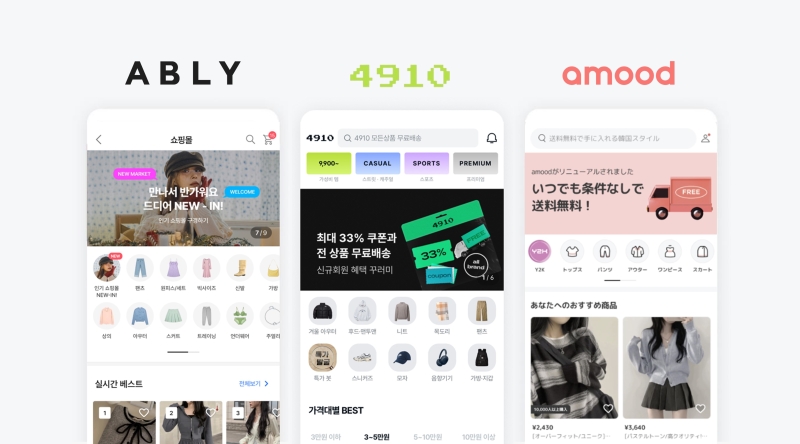Naver's Acquisition Rumors of Ably, Does This Make Sense?


- On February 2nd, news broke through media reports that Naver is pushing to acquire the fashion platform Ably. Naver has denied these rumors as baseless.
- However, given the recent growth trend of Naver's commerce business, such talks don't seem strange at all. This is because Naver's core competitive edge, "price comparison," is reportedly faltering.
- To explain the background, in the past, Korean commerce consumers started shopping with "Naver price comparison search." This led online marketplaces and shopping malls like Gmarket and 11Street to advertise their products on Naver Shopping to appear in the search results.
- The problem is, many Korean sellers list their products on multiple open markets, concentrating their products on Naver. This created a situation where it was difficult for any business to differentiate from Naver in terms of "price" and "product range." Most competition merely involved attaching coupons to secure higher visibility on Naver.
- But now, Naver's "price comparison" competitiveness is reportedly not what it used to be. Naver Shopping has introduced Naver’s own 'Smart Store,' attracting sellers with "lower fees" compared to open markets using Naver Shopping advertising products.
- This threatened the position of platforms that previously cooperated with Naver. In the same space of Naver Shopping, the same product from a seller on Naver and Gmarket could be displayed together. Sellers could sell their products at lower prices on Naver due to cheaper fees, leading to issues of Naver abusing its platform dominance.
- The emergence of Coupang cannot be ignored either. Coupang provided an overwhelmingly better customer experience in terms of convenience, on top of the standardized prices and ranges due to Naver. Customers started turning to the Coupang app instead of searching on Naver.
- Following Coupang's example, platforms reduced their dependency on Naver Shopping searches and rapidly increased their 'app' shares. Especially since the recession deepened in 2022, platforms have been focusing more on loyal app customers by reducing unnecessary marketing expenses.
- Actual data also shows that while the app shares of major open markets like Coupang, TMON, and Wemakeprice, and vertical platforms like Musinsa have significantly increased, clicks within Naver Shopping have decreased. This trend is expected to strengthen further.
- 10. Moreover, the emergence of platforms like AliExpress and Temu, wielding "ultra-low prices," has further diminished the value of price comparison. Naver’s nurtured seller ecosystem relies significantly on Chinese wholesale.
- Adding to the woes, Naver's recent transaction growth rate has slowed. According to Naver's Q4 2023 earnings report, overall commerce transactions grew by only 4.9% year-over-year (excluding the Poshmark acquisition effect), barely half of the 10.6% (preliminary) growth rate announced by the Korean Statistical Office for the same quarter.
- Of course, Naver received high marks for achieving record growth in overall business revenue for Q4 2023, including commerce. This can be attributed to Naver focusing on increasing the revenue (Take Rate) relative to transactions.
- However, this approach, while improving short-term performance, could diminish Naver’s influence in the e-commerce market long-term and erode growth potential. Particularly, the slowdown in transaction growth being attributed more to external shopping malls on Naver Shopping than to Naver’s own on-platform products is significant.
- Now, with Naver Commerce shaking from customer departure right from the search stage, Naver needs new growth engines. Against this backdrop, Naver has been focusing on vertical investments, particularly in the ‘fashion category’.
- Actions taken in this context, from acquiring North American C2C fashion platform Poshmark, launching Fashion Town integrating fashion-related services, to new investments in KREAM, can all be seen as part of this strategy. The rumors of acquiring Ably also emerged in this context.
- However, whether Ably is a suitable acquisition target for Naver is another issue. Certainly, Ably is performing well, recording its first annual profit in five years last year, and gradually gaining the upper hand in its long-standing competition with Zigzag for the women's fashion market.
- But that also means Ably is in no hurry, and if negotiations were to occur, the asking price could be much higher than the previously mentioned 1 trillion won. Finding the right timing, like Coupang's relatively bargain acquisition of bankrupt Farfetch, seems necessary.
- From Naver's perspective, acquiring Ably may not guarantee significant change to overall growth. According to reports, Ably's transaction volume was around 1.2 trillion won in 2022, and despite growth last year, it's estimated to be at most about 2 trillion won. While Ably continues to grow, it seems insufficient to be an alternative for Naver Commerce, which reported annual transactions of 43 trillion won last year.
- Moreover, Ably's greatest strength, Dongdaemun fulfillment, is facing a crisis. One of the initial points of interest in Ably was its fulfillment capabilities based in Dongdaemun. However, Dongdaemun fashion logistics faces efficiency challenges due to its complex internal structure. As a result, major Dongdaemun purchasing platforms are successively ending their fulfillment services.
- Consequently, Ably is promoting brand nurturing as another core strategy, but this area is already dominated by Musinsa, making it difficult to see as a distinct advantage. Zigzag, another e-commerce platform based on Dongdaemun, is also enhancing its brand stores.
- Thus, despite Ably's recent good performance, it may be too burdensome to acquire, and not as crucial for Naver. Therefore, the acquisition rumor, as officially stated by Naver, is likely to end as speculation.
- Especially for Naver, there are already excellent alternatives like KREAM and Poshmark. While KREAM's recent growth has slowed, it's already achieving transactions in the billions and is transforming from a resale platform to a brand fashion platform, which is a positive aspect. Poshmark, contrary to concerns at the time of acquisition, appears to have successfully improved its constitution.
- Therefore, Naver is in no hurry. While commerce transaction growth has stalled, revenue has surged, clearly serving as a solid source of profit. Naver already has many cards to play.
- However, there seems a need to further strengthen the growth potential of KREAM and Poshmark. If the Ably acquisition rumors turn out to be unfounded, it's highly likely that separate investment news to strengthen the fashion category will follow.
Contact us and we'll help you learn more and connect your business. cs@beyondx.ai
※ This content is produced in partnership with 'TrendLight' and CONNECTUS.
네이버의 에이블리 인수설, 이게 말이 되나요?
※ 이 콘텐츠는 커넥터스와 ‘트렌드라이트’의 제휴를 바탕으로 제작됐습니다. 1. 지난 2월 2일 네이버가 패션 플랫폼 에이블리 인수를 추진한다는 소식이 언론 보도를 통해 전해졌습니다. 이 소식에 대해서 네이버 측은 ‘사실무근’이라는 입장을 밝혔는데요. 2. 하지만 최근

뉴스레터를 구독하세요.
비욘드엑스의 뉴스레터를 구독하세요.



